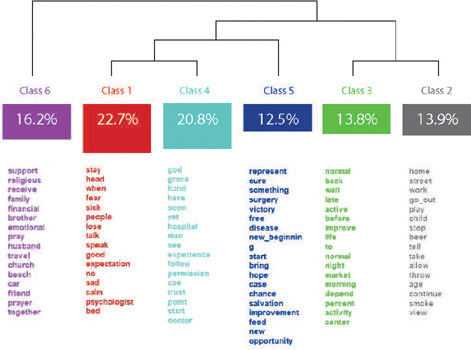-
Job satisfaction in an oncology nursing team
Revista Brasileira de Enfermagem. 2017;70(5):988-995
Abstract
Job satisfaction in an oncology nursing team
Revista Brasileira de Enfermagem. 2017;70(5):988-995
DOI 10.1590/0034-7167-2016-0422
Views0See moreABSTRACT
Objective:
to identify the level of attributed, perceived and real job satisfaction of oncology nursing professionals and analyze the relationships between the levels of satisfaction among these workers.
Method:
a descriptive, quantitative cross-sectional study was conducted using the Index of Work Satisfaction (IWS) to evaluate the nursing team, nurses and technicians/auxiliaries. A total of 348 workers answered the questionnaire, of which 216 were fully completed and considered for the IWS calculation.
Results:
Autonomy was considered the most important item in attributed satisfaction for the nursing team and nurses. Salary was valorized most by the technicians/auxiliaries. For perceived satisfaction, Professional Status was the most important for all workers. Regarding real satisfaction, Interaction was the most important for the nursing team and technicians/auxiliaries; while the nurses valorized Autonomy. The nurses presented the greatest job satisfaction.
Conclusion:
a discrepancy was observed in job satisfaction among the oncology nurses, indicating the importance of further quantitative research.
-
Relational technologies as instruments of care in the Family Health Strategy
Revista Brasileira de Enfermagem. 2017;70(5):981-987
Abstract
Relational technologies as instruments of care in the Family Health Strategy
Revista Brasileira de Enfermagem. 2017;70(5):981-987
DOI 10.1590/0034-7167-2016-0337
Views0See moreABSTRACT
Objective:
This article aims to identify the relational technologies used by Family Health Strategy nurses in their daily work when treating patients.
Method:
Descriptive and cross-sectional study with qualitative approach; conducted between May and July 2015, in three Basic Health Units of the Southern Region of the Municipality of São Paulo, with 19 nurses of the Family Health Strategy. Data were collected through a semi-structured interview, and the speeches were fully transcribed and analyzed according to the technique of content analysis.
Results:
From the speeches of the participants, three categories emerged, showing the unawareness of the concept, but the valorization of its use; which are the relational technologies used by the participating nurses (communication, listening, empathy and welcoming reception), as well as the report of barriers to the use of relational technologies.
Final consideration:
Although the nurses value the use of relational technologies, the participants denoted unawareness of the nomenclature and its associated concepts, suggesting superficiality in the understanding and use of these instruments in the context of care in the Family Health Strategy.
-
Knowledge and practice in mental health nursing care
Revista Brasileira de Enfermagem. 2017;70(5):973-980
Abstract
Knowledge and practice in mental health nursing care
Revista Brasileira de Enfermagem. 2017;70(5):973-980
DOI 10.1590/0034-7167-2016-0343
Views0See moreABSTRACT
Objective:
To understand mental health nursing care based on the concept of the subject of the unconscious proposed by Lacan.
Method:
A narrative study was carried out with 19 nurses, chosen based on their theoretical approach or referral by other participants, through the snowball sampling technique. The interviews were carried out in person or digitally, and were recorded and fully transcribed.
Results:
The analysis was carried out based on Freudian and Lacanian psychoanalysis, approaching nursing care as it acts on the body, secretions, and excretions, to distinguish it from the spirit of fineness. Effects on care are discussed, considering the subject of the unconscious with its knowledge, creating unique exits (sinthome). In this situation, professionals are required to abstain from a position of knowing what is better for the Other.
Final considerations:
This nursing care perspective offers contributions when discussing the centrality of the subject and words in the care process.
-
Weaving the West Psychosocial Care Network of the municipality of São Paulo
Revista Brasileira de Enfermagem. 2017;70(5):965-972
Abstract
Weaving the West Psychosocial Care Network of the municipality of São Paulo
Revista Brasileira de Enfermagem. 2017;70(5):965-972
DOI 10.1590/0034-7167-2016-0566
Views0See moreABSTRACT
Objective:
to understand how health service professionals involved in the care of users in psychic distress perceive the organization of the Psychosocial Care Network (RAPS – Rede de Atenção Psicossocial) in the western region of the city of São Paulo.
Method:
qualitative approach study conducted with 123 professionals with higher education who work in the care points of the network. A semi-structured interview was performed and data were submitted to the Alceste program for lexical analysis.
Results:
the network is in process of alignment with the mental health policy and the psychosocial rehabilitation strategy. However, the weaknesses in the work process of teams are related to deficits in human resources, structure, and communication, and to the limited appropriation of their guidelines.
Final considerations:
there are intense efforts of workers to weave the network, and barriers need to be overcome to support successful actions in mental health care in the territory.
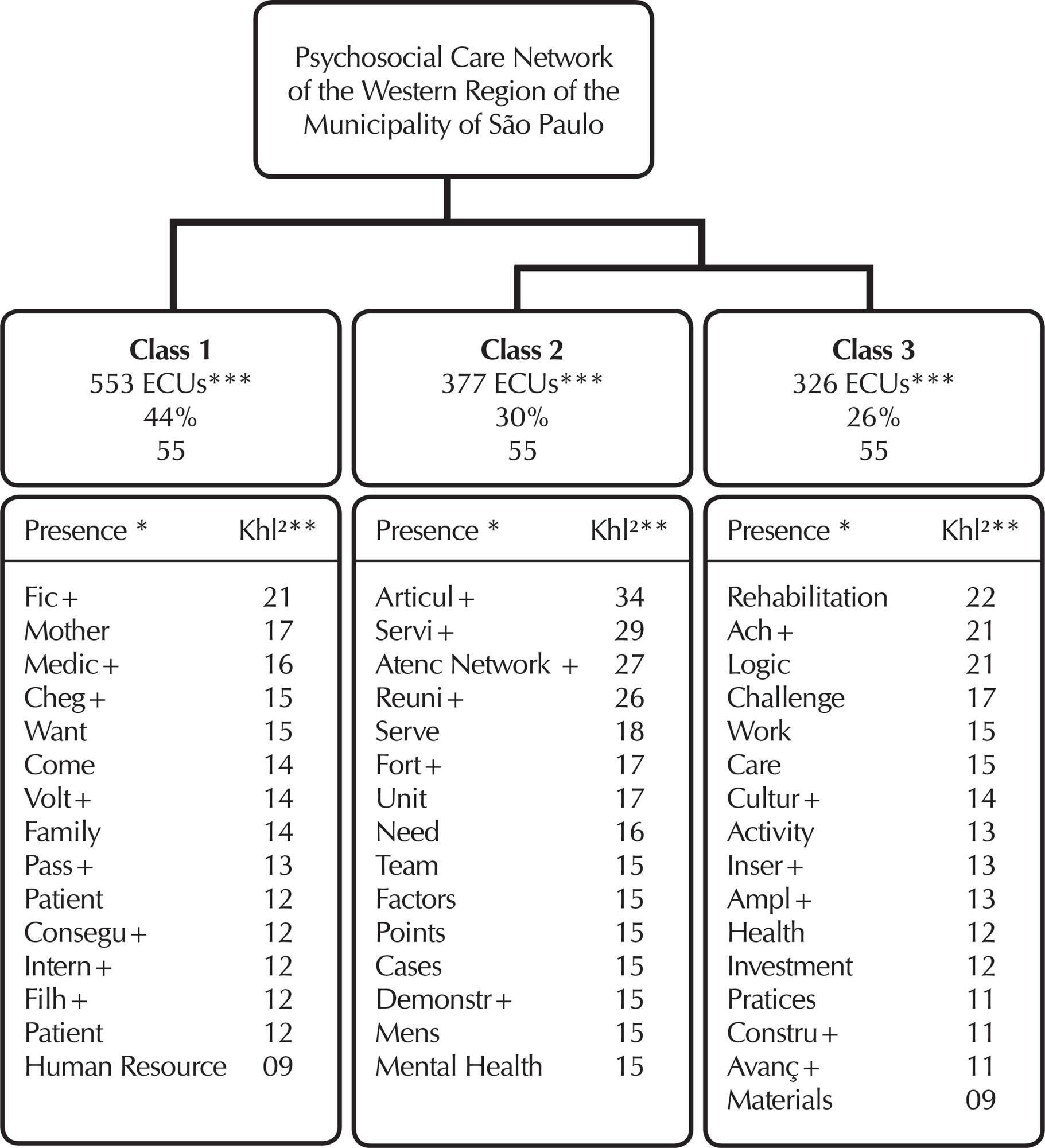
-
Chronotype and work shift in nursing workers of university hospitals
Revista Brasileira de Enfermagem. 2017;70(5):958-964
Abstract
Chronotype and work shift in nursing workers of university hospitals
Revista Brasileira de Enfermagem. 2017;70(5):958-964
DOI 10.1590/0034-7167-2016-0542
Views0See moreABSTRACT
Objective:
To identify the predominant chronotype in nursing workers who work in surgical clinics of university hospitals and to verify the association with work shift.
Method:
Cross-sectional study, performed in surgical clinics of university hospitals in the Southern region of Brazil. The sample of 270 nursing workers answered questions of socio-occupational characterization, of health and the Morningness-Eveningness Questionnaire of Horne and Östberg. We performed a descriptive and bivariate analysis with the help of the SPSS software and confidence interval of 95%.
Results:
The indifferent chronotype predominated (45.2%). There were significant differences between occupational categories and variables “age” (p<0.001), “use of medication” (p=0.035) and “choice of work shift” (p=0.001). There was an association between the chronotype and the variables “work leave due to illness” (p=0.021), “children” (p=0.025), “use of medication” (p=0.018) and “work shift” (p=0.001).
Conclusion:
The chronotype remained indifferent, and the results confirmed association between chronotype and work shift.
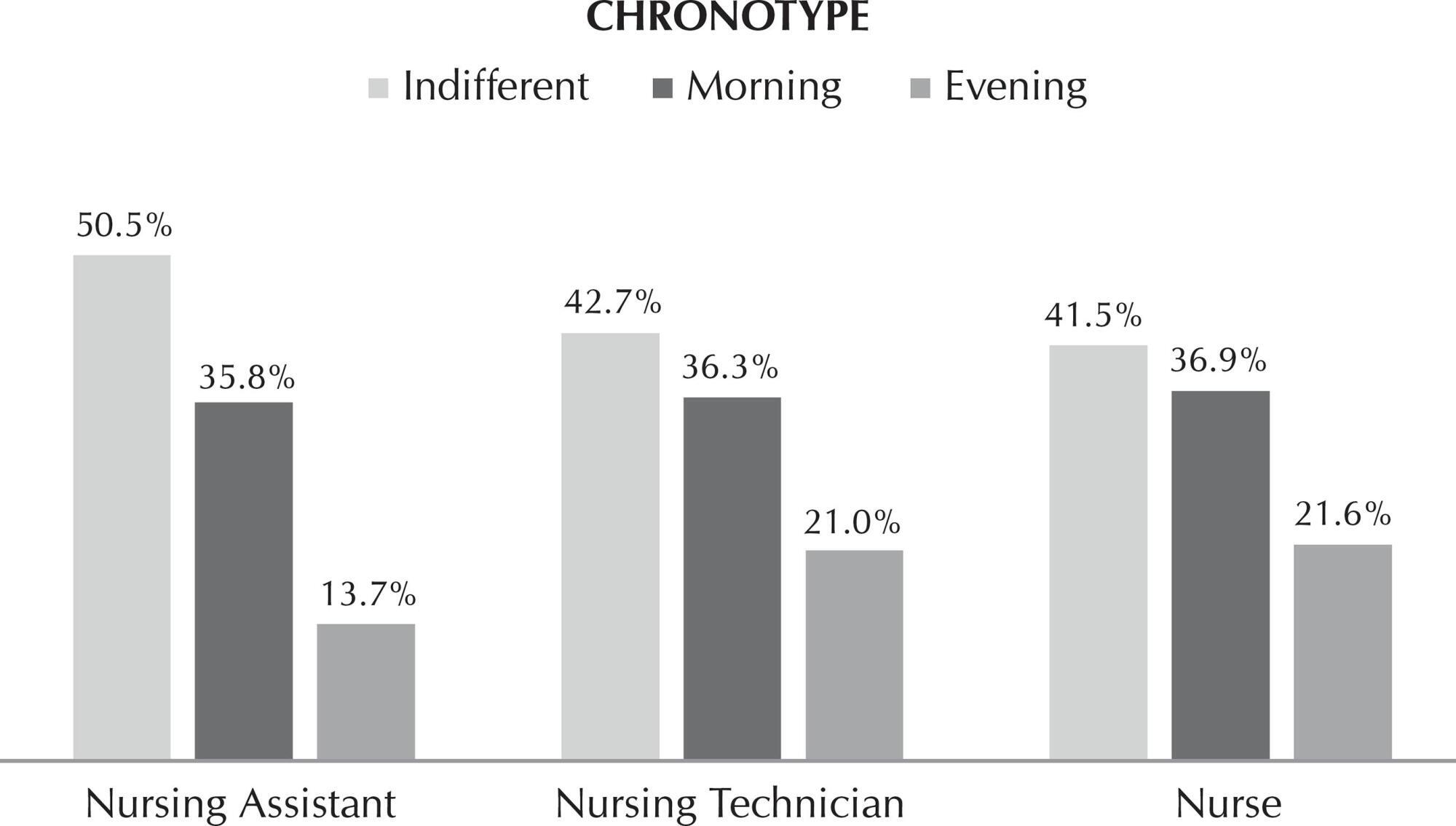
-
Difficulties in nutritional counseling and child growth follow-up: from a professional perspective
Revista Brasileira de Enfermagem. 2017;70(5):949-957
Abstract
Difficulties in nutritional counseling and child growth follow-up: from a professional perspective
Revista Brasileira de Enfermagem. 2017;70(5):949-957
DOI 10.1590/0034-7167-2016-0527
Views0ABSTRACT
Introduction:
Nutritional counseling and growth follow-up are priorities when providing care to children; however, these have not been completely incorporated into primary health care.
Objective:
To know the difficulties for providing nutritional counseling and child growth follow-up, from a professional healthcare perspective.
Method:
Qualitative study, using Donabedian as theoretical framework, developed by 53 professionals in the field of primary health care. Data was obtained from focal groups and submitted to content analysis.
Results:
The main difficulties for nutritional counseling were clustered in the category of ‘perceptions and beliefs related to child feeding’. The ‘problems of infrastructure and healthcare’ and ‘maintenance of the hegemonic medical model’ are the main difficulties for following-up growth.
Final considerations:
Besides investments in infrastructure, healthcare training is indispensable considering beliefs and professional experiences, so in fact, nutritional counseling and child growth follow-up are incorporated in primary health care.
Keywords:Child NutritionChildcareNursing Primary Health CarePrimary Health CareResearch, QualitativeSee more
-
Severity and workload related to adverse events in the ICU
Revista Brasileira de Enfermagem. 2017;70(5):942-948
Abstract
Severity and workload related to adverse events in the ICU
Revista Brasileira de Enfermagem. 2017;70(5):942-948
DOI 10.1590/0034-7167-2016-0427
Views0See moreABSTRACT
Objective:
To analyze whether an increase in patient severity and nursing workload are correlated to a greater incidence of adverse events (AEs) in critical patients.
Method:
A prospective single cohort study was performed on a sample of 138 patients hospitalized in an intensive care unit (ICU).
Results:
A total of 166 AEs, occurred, affecting 50.7% of the patients. Increased patient severity presented a direct relationship to the probability of AEs occurring. However, nursing workload did not present a statistically significant relationship with the occurrence of AEs.
Conclusion:
The results cast light on the importance of using evaluation tools by the nursing personnel in order to optimize their daily activities and focus on patient safety.
-
Mental health in the Family Health Strategy as perceived by health professionals
Revista Brasileira de Enfermagem. 2017;70(5):935-941
Abstract
Mental health in the Family Health Strategy as perceived by health professionals
Revista Brasileira de Enfermagem. 2017;70(5):935-941
DOI 10.1590/0034-7167-2016-0492
Views0See moreABSTRACT
Objective:
to analyze the management of mental health needs in primary care as perceived by Family Health Strategy professionals.
Method:
this was a qualitative descriptive exploratory study developed within the coverage area of five family health teams. The data were collected using observation, group interviews, individual semi-structured interviews, and focus groups. Content analysis was conducted using text analysis software and interpretation was based on the corresponding analytical structures.
Results:
numerous and challenging mental health demands occur in this setting, for which the teams identified care resources; however, they also indicated difficulties, especially related to the operationalization and integration of such resources.
Conclusion:
there is a need for a care network sensitive to mental health demands that are better coordinated and more effectively managed.
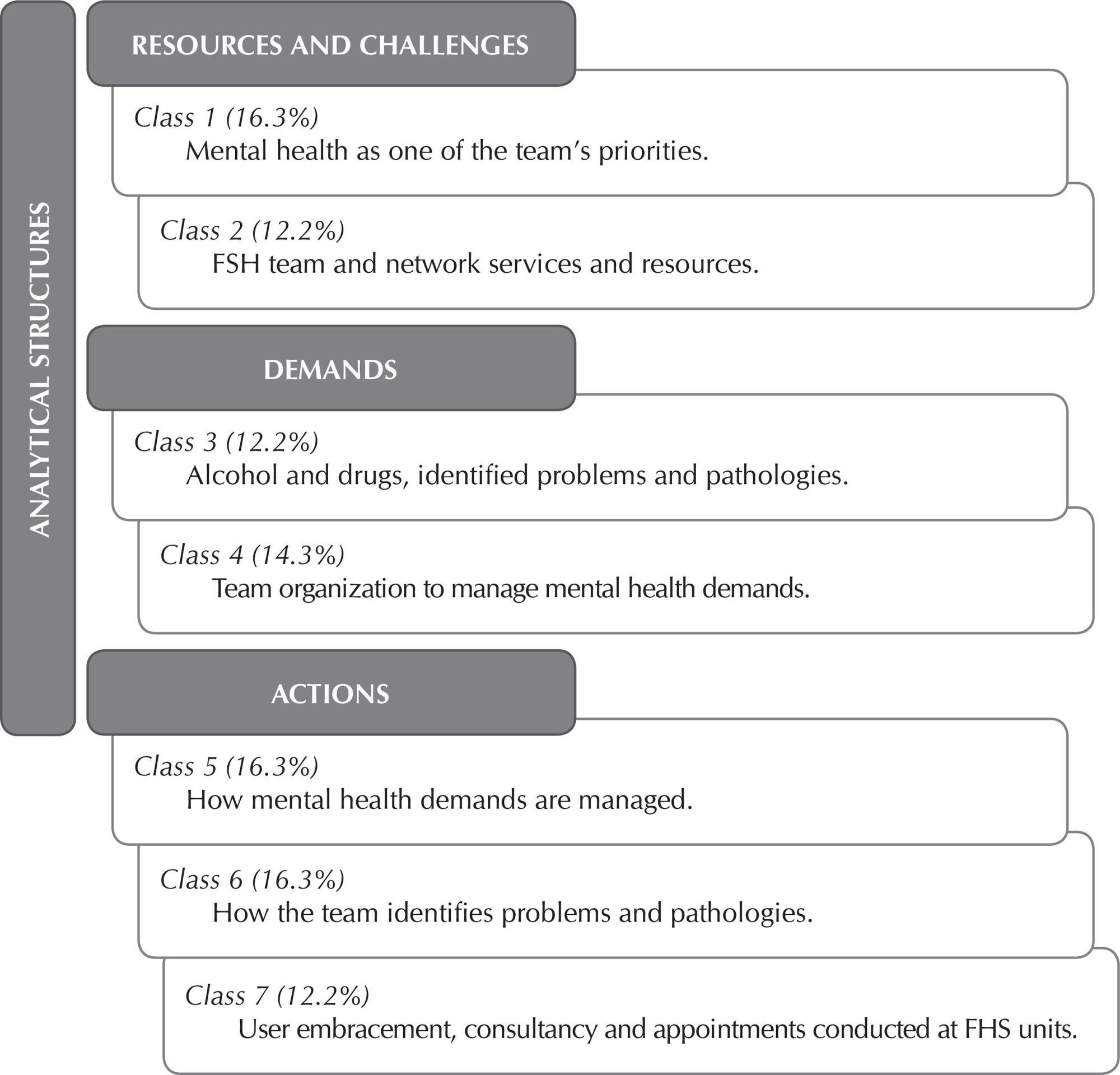
-
ORIGINAL ARTICLE11-27-2023
Incidents in the context of pre-hospital care by ambulances: contributions to patient safety
Revista Brasileira de Enfermagem. 2023;76(5):e20220657
Abstract
ORIGINAL ARTICLEIncidents in the context of pre-hospital care by ambulances: contributions to patient safety
Revista Brasileira de Enfermagem. 2023;76(5):e20220657
DOI 10.1590/0034-7167-2022-0657
Views0See moreABSTRACT
Objectives:
to analyze the occurrence of incidents in the context of mobile terrestrial pre-hospital care.
Methods:
a descriptive research was carried out through the observation of 239 treatments performed by 22 healthcare professionals at the Mobile Emergency Care Service, located in Baixada Fluminense, Rio de Janeiro, Brazil. Fisher’s exact test and chi-square test were used for data analysis.
Results:
the total time dedicated to patient care was 439.5 hours, during which 2386 security incidents were observed. The most notable ones were related to written communication (235), patient identification through bracelets (238), and safety in medication preparation (81).
Conclusions:
the need to promote and implement initiatives aimed at patient safety is evident, with special focus on international safety goals within the scope of mobile pre-hospital care services.

-
Saberes do enfermeiro e comunicação terapêutica no hospital
Revista Brasileira de Enfermagem. 2023;76(5):e20220617
Abstract
Saberes do enfermeiro e comunicação terapêutica no hospital
Revista Brasileira de Enfermagem. 2023;76(5):e20220617
DOI 10.1590/0034-7167-2022-0617
Views0See moreRESUMEN
Objetivos:
identificar la correlación entre el conocimiento de los enfermeros y la aplicación de la comunicación terapéutica de los enfermeros en los hospitales.
Métodos:
estudio descriptivo, cuantitativo, correlacional con método de muestreo total. Los encuestados fueron 68 enfermeros que trabajaban en una sala del hospital. Se utilizaron cuestionarios modificados para recopilar datos. Los datos se analizaron mediante el análisis de la prueba de chi-cuadrado de Pearson.
Resultados:
los enfermeros con conocimientos suficientes y pobres tienen una buena aplicación de la comunicación terapéutica. No hubo correlación entre el conocimiento y la aplicación de la comunicación terapéutica.
Conclusiones:
la comunicación terapéutica está influenciada por muchos factores. El conocimiento de los enfermeros debe ser mantenido y mejorado para brindar una atención integral y aumentar la satisfacción del paciente.
-
ORIGINAL ARTICLE11-27-2023
Nurses’ knowledge and therapeutic communication in hospital
Revista Brasileira de Enfermagem. 2023;76(5):e20220617
Abstract
ORIGINAL ARTICLENurses’ knowledge and therapeutic communication in hospital
Revista Brasileira de Enfermagem. 2023;76(5):e20220617
DOI 10.1590/0034-7167-2022-0617
Views0See moreABSTRACT
Objectives:
to identify the correlation of nurses’ knowledge with the application of nurses’ therapeutic communication in hospitals.
Methods:
a descriptive quantitative, correlational design with a total sampling method was used in the study. Respondents were 68 nurses working in an inpatient room in one of the general hospitals in western Indonesia. Modified questionnaires were used in data collection. Analysis of the Pearson chi-square test was used in data analysis.
Results:
nurses with sufficient and poor knowledge have a good application of therapeutic communication. There was no correlation between knowledge and the application of nurses’ therapeutic communication.
Conclusions:
therapeutic communication is influenced by many factors, but nurses’ knowledge should be maintained and improved to provide holistic care and increase patient satisfaction.
-
Adaptação transcultural da Breastfeeding Self-Efficacy Scale Short Form (BSES-SF) modificada para mães de prematuros no Brasil
Revista Brasileira de Enfermagem. 2023;76(5):e20220497
Abstract
Adaptação transcultural da Breastfeeding Self-Efficacy Scale Short Form (BSES-SF) modificada para mães de prematuros no Brasil
Revista Brasileira de Enfermagem. 2023;76(5):e20220497
DOI 10.1590/0034-7167-2022-0497
Views0RESUMEN
Objetivos:
realizar la adaptación transcultural de la Breastfeeding Self-Efficacy Scale-Short Form (BSES-SF) para madres de niños enfermos y/o prematuros al portugués en el contexto brasileño.
Métodos:
se realizó un estudio metodológico que incluyó la traducción del instrumento, síntesis de traducciones, revisión por especialistas, síntesis, reevaluación por especialistas, retrotraducción, preprueba y validación de contenido. El estudio involucró a 19 participantes, incluidos traductores y expertos. Además, 18 madres de la población objetivo fueron incluidas en la preprueba.
Resultados:
las equivalencias de opinión obtenidas por el comité de expertos fueron: semántica (85%), idiomática (89%), cultural (86%) y conceptual (94%). El Coeficiente de Validación de Contenido (CVC) de la escala fue de 0,93 para claridad y comprensión; 0,89 para relevancia práctica; 0,92 para relevancia. El promedio general del CVC fue de 0,91.
Conclusiones:
la escala fue traducida y adaptada al portugués brasileño, lo que mantuvo las equivalencias y confirmó la validez de contenido.
Keywords:Aleitamento MaternoAutoeficaciaEstudo de ValidaçãoPesquisa Metodológica em EnfermagemRecém-Nascido PrematuroSee more -
ORIGINAL ARTICLE11-27-2023
Cross-cultural adaptation of the Breastfeeding Self-Efficacy Scale Short Form (BSES-SF) modified for preterm mothers in Brazil
Revista Brasileira de Enfermagem. 2023;76(5):e20220497
Abstract
ORIGINAL ARTICLECross-cultural adaptation of the Breastfeeding Self-Efficacy Scale Short Form (BSES-SF) modified for preterm mothers in Brazil
Revista Brasileira de Enfermagem. 2023;76(5):e20220497
DOI 10.1590/0034-7167-2022-0497
Views0ABSTRACT
Objectives:
to conduct a cross-cultural adaptation of the Breastfeeding Self-Efficacy Scale-Short Form (BSES-SF) for mothers of ill and/or preterm infants among Portuguese-speaking mothers in Brazil.
Methods:
a methodological study was completed, including the translation of the tool, synthesis of translations, review by experts, synthesis, reassessment of experts, back-translation, pre-test, and validation of the content. The study involved 19 participants, including a translator and experts. In addition, 18 mothers from the target population were included in the pre-test.
Results:
the equivalences of the opinion obtained by the committee of experts were semantic (85%), idiom (89%), cultural (86%), and conceptual (94%). The content validation coefficient (CVC) on the scale was 0.93 for clarity and understanding; 0.89 for practical relevance; 0.92 for relevance; and the average overall CVC was 0.91.
Conclusions:
the scale was translated and adapted to the Brazilian Portuguese language, which maintained the equivalences and confirmed the content validity.
Keywords:BreastfeedingMethodological Research in NursingPremature NewbornSelf-EfficacyValidation StudySee more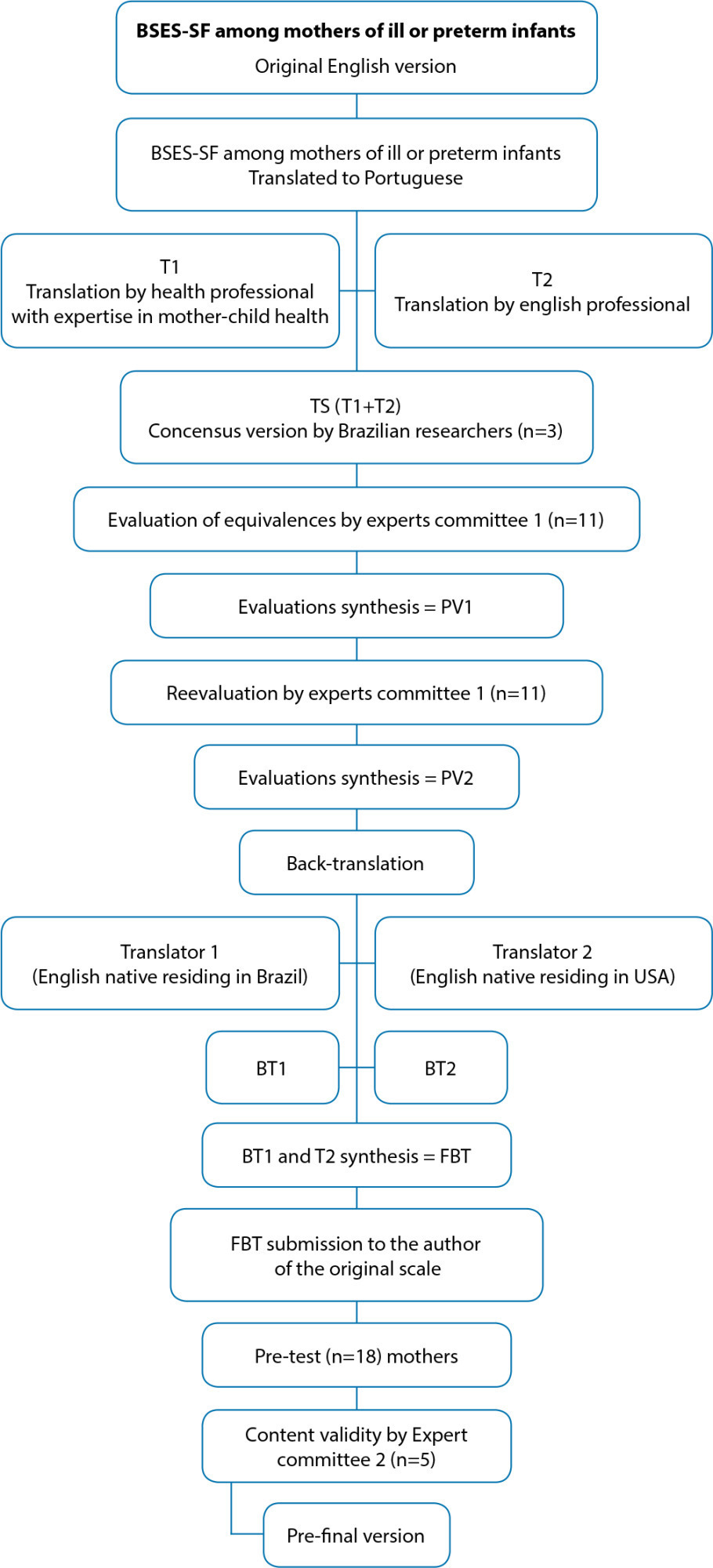
-
ORIGINAL ARTICLE11-27-2023
Puerperal women’s satisfaction with the obstetric services received: improvement of an assessment instrument
Revista Brasileira de Enfermagem. 2023;76(5):e20220457
Abstract
ORIGINAL ARTICLEPuerperal women’s satisfaction with the obstetric services received: improvement of an assessment instrument
Revista Brasileira de Enfermagem. 2023;76(5):e20220457
DOI 10.1590/0034-7167-2022-0457
Views0ABSTRACT
Objectives:
to improve an instrument that measures postpartum women’s satisfaction with obstetric care.
Methods:
action research, developed from a preliminary version of an instrument prepared by nurse-midwives working in public services in the Federal District. The analysis of the results of application of instrument carried out in a pilot test, analysis of evidence of instrument validity, literature review, focus group with the instrument’s developers and interview with the target audience were carried out.
Results:
factorial analysis showed three existing factors in the construct. Seven nurses participated, discussing the instrument reformulation, and 20 mothers reported their perceptions about the care received during childbirth, generating five thematic units.
Final Considerations:
instrument improvement occurred through item and response scale reconstruction and reorganization, in addition to application of a pre-test with the target population, resulting in an instrument composed of 13 items.
Keywords:Health Services ResearchParturitionPatient SatisfactionSurveys and QuestionnairesWomen's HealthSee more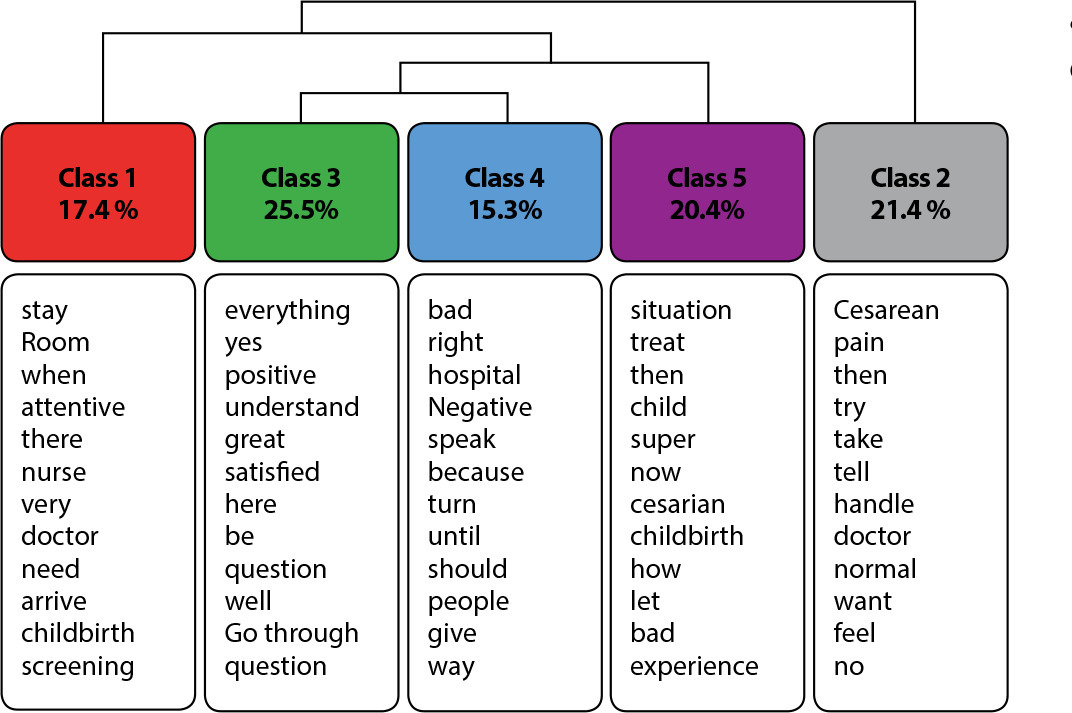
-
Proposta do diagnóstico de enfermagem “Retorno Venoso Periférico Prejudicado”: formação do conceito
Revista Brasileira de Enfermagem. 2023;76(5):e20220426
Abstract
Proposta do diagnóstico de enfermagem “Retorno Venoso Periférico Prejudicado”: formação do conceito
Revista Brasileira de Enfermagem. 2023;76(5):e20220426
DOI 10.1590/0034-7167-2022-0426
Views0RESUMEN
Objetivos:
desarrollar una propuesta de diagnóstico de enfermería centrada en el retorno venoso.
Métodos:
se trata de un análisis de concepto según el modelo propuesto por Walker y Avant, que se operacionaliza a través de una revisión integradora. El estudio se llevó a cabo de acuerdo con las recomendaciones del protocolo Preferred Reporting Items for Systematic Reviews and Meta-Analyses.
Resultados:
el análisis de los 131 estudios permitió identificar atributos, antecedentes y consecuencias. El atributo más común fue la disminución del flujo venoso. Los antecedentes encontrados con mayor frecuencia fueron deficiencia valvular estructural y/o funcional, edad avanzada y trombosis venosa periférica. Las consecuencias más comunes fueron edema periférico, úlcera venosa y dolor en la extremidad.
Conclusiones:
el diagnóstico de enfermería formulado fue propuesto como parte del Dominio 4, Actividad/reposo, en la Clase 4, Respuestas cardiovasculares/pulmonares, con ocho características definidoras, cinco factores relacionados, seis poblaciones de riesgo y cuatro condiciones asociadas.
Keywords:Diagnóstico de EnfermagemExtremidade InferiorFormação de ConceitoInsuficiência VenosaProcesso de EnfermagemSee more
-
ERRATUM01-13-2024
ERRATUM
Revista Brasileira de Enfermagem. 2024;77(6):e2024n6e08
Abstract
ERRATUMERRATUM
Revista Brasileira de Enfermagem. 2024;77(6):e2024n6e08
DOI 10.1590/0034-7167.20247706e08
Views0In the article “Brazilian nursing specific situation, middle and micro-range theories: a bibliometric study”, with DOI number: , published in Revista Brasileira de Enfermagem, 2024;77(4):e20230520, Chart 1:Where it read:[…]See more -
ERRATUM01-13-2024
ERRATA
Revista Brasileira de Enfermagem. 2024;77(6):e2024n6e07
Abstract
ERRATUMERRATA
Revista Brasileira de Enfermagem. 2024;77(6):e2024n6e07
DOI 10.1590/0034-7167.20247706e06pt
Views0No artigo “Crenças e atitudes de pais ou responsáveis legais sobre a vacinação infantil: revisão de escopo”, com número DOI: , publicado no periódico Revista Brasileira de Enfermagem, 2024;77(4):e20240126, página 5:Onde se lia:[…]See more -
ORIGINAL ARTICLE01-13-2024
Indicators associated with severity and mortality in hospitalized people with HIV: A retrospective cohort
Revista Brasileira de Enfermagem. 2024;77(6):e20240204
Abstract
ORIGINAL ARTICLEIndicators associated with severity and mortality in hospitalized people with HIV: A retrospective cohort
Revista Brasileira de Enfermagem. 2024;77(6):e20240204
DOI 10.1590/0034-7167-2024-0204
Views0See moreABSTRACT
Objectives:
to compare the sociodemographic and clinical severity indicators of hospitalized people with HIV in relation to clinical outcomes and urgent hospital admission.
Methods:
a retrospective cohort study was conducted with 102 medical records of HIV-infected individuals hospitalized in a hospital in southern Brazil. In addition to descriptive analysis, Fisher’s exact test, Pearson’s Chi-square, and logistic regression were used.
Results:
the data showed a significant direct effect on severity indicators in the following variables: male sex (p=0.013), skin color (p=0.023), level of education (p=0.000), urgent admissions (p=0.000), late diagnosis (p=0.001), diabetes mellitus (p=0.001), hypertension (p=0.004), kidney disease (p=0.002), high viral load (p=0.006), CD4+ count below 200 (p=0.005), fever (p=0.016), weight loss (p=0.013), co-infection with hepatitis C (p=0.004), and mortality (p=0.007).
Conclusions:
three sociodemographic and thirteen clinical markers were identified as being associated with the risk of clinical deterioration in hospitalized people with HIV.
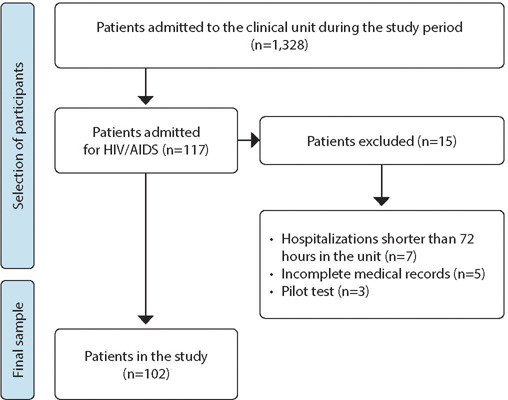
-
ORIGINAL ARTICLE01-13-2024
Nurses’ perspectives on the use of telemonitoring in the management of people with diabetes and hypertension
Revista Brasileira de Enfermagem. 2024;77(6):e20230481
Abstract
ORIGINAL ARTICLENurses’ perspectives on the use of telemonitoring in the management of people with diabetes and hypertension
Revista Brasileira de Enfermagem. 2024;77(6):e20230481
DOI 10.1590/0034-7167-2023-0481
Views1See moreABSTRACT
Objectives:
to understand the perspective of nurses on the use of telemonitoring in the management of people with type 2 diabetes mellitus and arterial hypertension in primary care.
Methods:
this qualitative research involved sixteen nurses from eight municipalities in Paraná. Data were collected between November 2022 and January 2023 through inperson or remote interviews, which were audio-recorded and subjected to content analysis.
Results:
according to the nurses, telemonitoring enhances users’ knowledge about these conditions, communication and connection with the team, and productivity. However, the lack of electronic resources and equipment, high staff turnover, low user adherence, and the limited availability of professional time present significant challenges.
Final Considerations:
the effective implementation and operation of telemonitoring in the management of people with diabetes and hypertension involve both potential benefits and barriers. It is essential to have the availability of human and technological resources, managerial support, and the commitment of professionals and users.
-
ORIGINAL ARTICLE01-13-2024
Knowledge, Attitudes, and Practices of nurses regarding blood culture collection
Revista Brasileira de Enfermagem. 2024;77(6):e20230424
Abstract
ORIGINAL ARTICLEKnowledge, Attitudes, and Practices of nurses regarding blood culture collection
Revista Brasileira de Enfermagem. 2024;77(6):e20230424
DOI 10.1590/0034-7167-2023-0424
Views0ABSTRACT
Objectives:
to investigate the knowledge, attitudes, and practices of nurses regarding blood culture collection.
Methods:
a cross-sectional study was conducted in five Brazilian public hospitals with 112 nurses. Data were collected using an adapted questionnaire and analyzed through descriptive and inferential statistics.
Results:
nurses who did not consider themselves capable of collecting blood cultures had a 72% lower chance of performing the collection at the recommended site and an 83% lower chance of using the same needle for blood inoculation into the vials. Nurses working in the emergency department had a 75% lower chance of knowing the international benchmark for blood culture contamination rates, and those with less than 5 years in the position decreased their chance of accuracy in this matter by 79%.
Conclusions:
there are gaps in the knowledge, attitudes, and practices of nurses regarding blood culture collection. Standardization of the technique, periodic education, supervision and guidance of the collection team, and process auditing are recommended coping strategies.
Keywords:Blood CultureBlood Specimen CollectionHealth Knowledge, Attitudes, PracticeNursing CareQuality of Health CareSee more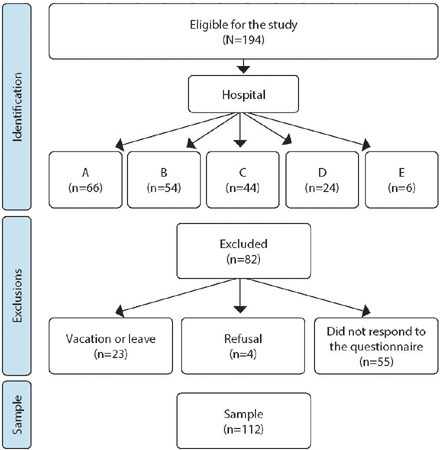
-
ORIGINAL ARTICLE01-13-2024
Evaluation of care for people with HIV in Primary Health Care: construct validation
Revista Brasileira de Enfermagem. 2024;77(6):e20230190
Abstract
ORIGINAL ARTICLEEvaluation of care for people with HIV in Primary Health Care: construct validation
Revista Brasileira de Enfermagem. 2024;77(6):e20230190
DOI 10.1590/0034-7167-2023-0190
Views0ABSTRACT
Objectives:
to verify the construct validation of an instrument for evaluating care for people living with HIV in Primary Health Care.
Methods:
methodological study carried out in 2021 with 260 health professionals in Recife, PE. Validation based on the internal structure was carried out at this stage using exploratory and confirmatory factor analysis, and validity based on item response theory.
Results:
the validation determined the retention of five factors and 63 items. The instrument’s internal consistency and quality of fit was 0.90, the Tukey-Lewis index was 0.915 and the comparative fit index was 0.918 in the confirmatory factor analysis. The indication for the absolute majority of items is adequate fit.
Conclusions:
the instrument has construct validity, making it possible to use it to evaluate the decentralization process and care for People Living with HIV in Primary Health Care.
Keywords:Acquired Immunodeficiency SyndromeComprehensive Health CareHIVPrimary Health CareProgram EvaluationSee more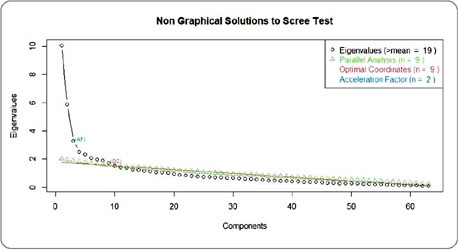
-
ORIGINAL ARTICLE01-10-2024
Inventory of ethical problems in mobile pre-hospital care
Revista Brasileira de Enfermagem. 2024;77:e20230539
Abstract
ORIGINAL ARTICLEInventory of ethical problems in mobile pre-hospital care
Revista Brasileira de Enfermagem. 2024;77:e20230539
DOI 10.1590/0034-7167-2023-0539
Views0See moreABSTRACT
Objective:
to construct and validate the content of an inventory of ethical problems experienced by nurses in mobile pre-hospital care.
Method:
a psychometric approach study, developed with the following stages: (1) instrument construction through a theoretical matrix based on deliberative bioethics, scoping review and online qualitative research; (2) content validity by judges; (3) pre-testing with Mobile Emergency Care Service nurses in various Brazilian states. For content validity analysis, the Content Validity Ratio was calculated (CVR>0.45 for judges and CVR>0.35 for the target population).
Results:
the instrument had 44 items, distributed across four dimensions.
Final considerations:
the constructed instrument presented sources of evidence of content validity, providing good psychometric measurements and constituting a useful tool for nurses’ practice in the pre-hospital setting.
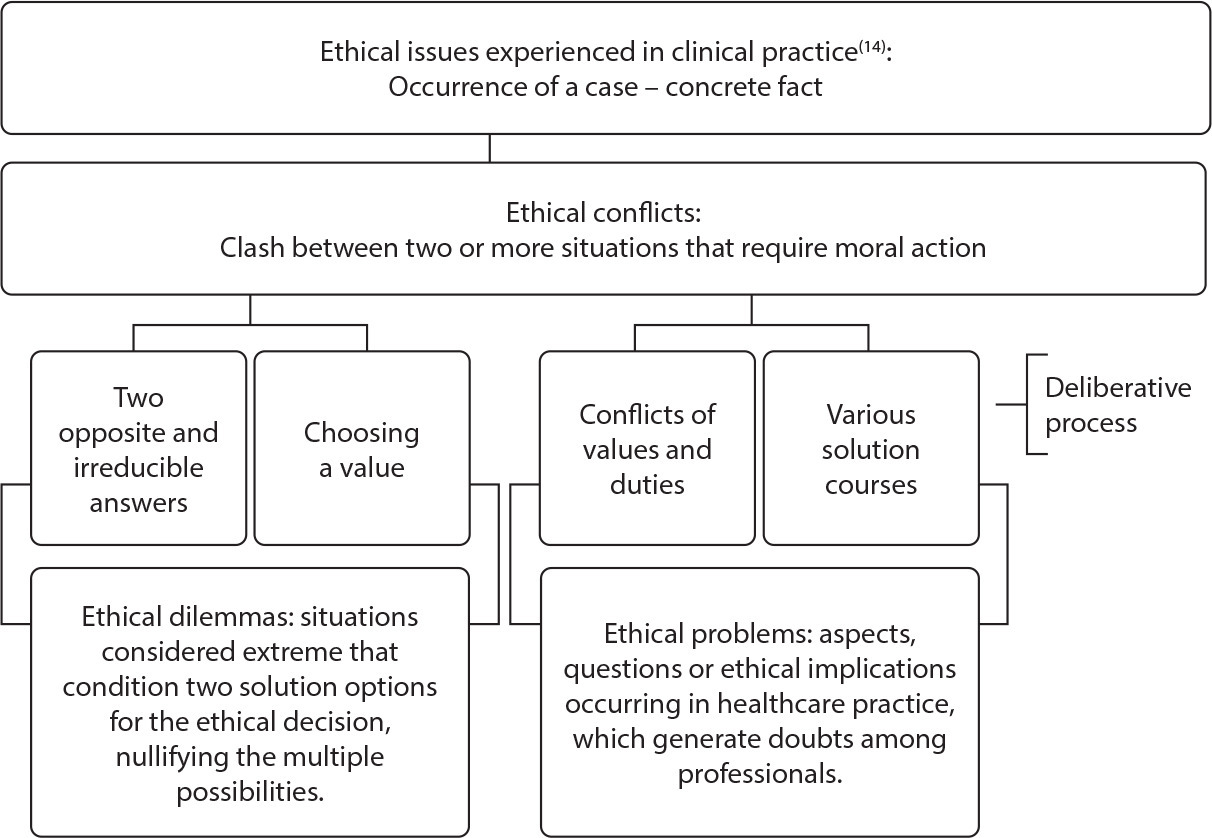
Search
Search in:
Nuvem de Tags
Aged (144) Atenção Primária à Saúde (239) COVID-19 (104) Cuidados de Enfermagem (269) Educação em Enfermagem (151) Educação em Saúde (139) Enfermagem (930) Estudos de Validação (131) Health Education (144) Idoso (208) Mental Health (149) Nursing (987) Nursing Care (306) Patient Safety (151) Primary Health Care (284) Qualidade de Vida (104) Quality of Life (106) Saúde Mental (145) Segurança do Paciente (150) Validation Studies (108)




